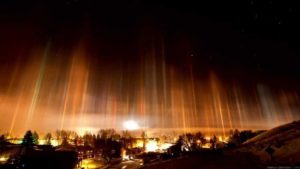How Do Light Pillars Occur – Solar and Lunar
A rare atmospheric and optical phenomenon, light pillars are only visible under very specific conditions.
They form when light from a source low in the sky – such as the setting Sun or even streetlights – reflects off millions of fl at, hexagonal ice crystals in the air and into your eyes or camera.
The columns of light are not physically present, but if you stand in the right spot, with the ice crystals roughly halfway between you and the light source, the optical illusion occurs.
As well as being cold enough for the ice crystals to form, the weather must be very calm so that the crystals can fall gently through the air while remaining in a horizontal orientation, tilting slightly from side to side. It’s these tilted crystals that elongate the refl ection into a column, and the higher they are in the sky, the taller the column will be.
Light pillars caused by the Sun are called Solar or Sun pillars, while those caused by the Moon’s light are called Lunar or Moon pillars.
Maybe you would like to know How Does A Black Hole Effect Light!
Halo (optics of the atmosphere)
 Halo is the optical phenomena in the Earth’s atmosphere (atmospheric optics) when the sun or moon visible through a thin layer of clouds with ice crystals.
Halo is the optical phenomena in the Earth’s atmosphere (atmospheric optics) when the sun or moon visible through a thin layer of clouds with ice crystals.
The best known is a circle around the sun or moon (full or part) 22° to the diameter on the inside of a reddish, and on the outside of bluish color. Much less common is the halo of a diameter of 44°.
The false Sun
The false Sun in Earth’s atmosphere represents the optical appearance of two bright spots on 22° on both sides of the Sun at the same height above the horizon.
The phenomenon is related to halo, and occurs when the sun (rarely moon) shines through thin cloud of hexagonal ice crystals, which are oriented so that their main (hexagonal) axis is oriented vertically.
Read also What Is Firestorm Phenomenon! and How Aurora Lights Are Formed!

Comments are closed.